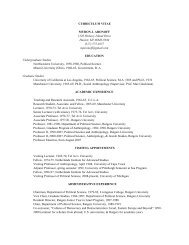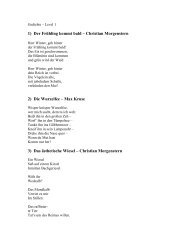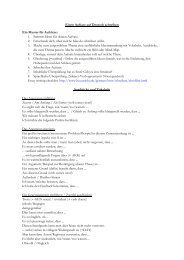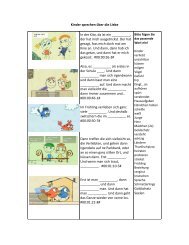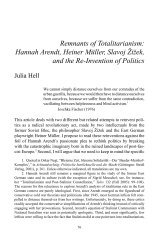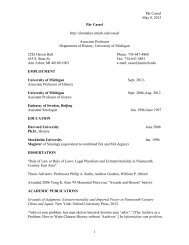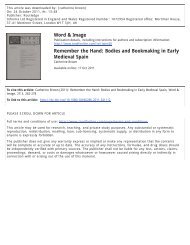Making History Personal: Constantine Cavafy and the Rise of Rome
Making History Personal: Constantine Cavafy and the Rise of Rome
Making History Personal: Constantine Cavafy and the Rise of Rome
Create successful ePaper yourself
Turn your PDF publications into a flip-book with our unique Google optimized e-Paper software.
Frier, “<strong>Making</strong> <strong>History</strong> <strong>Personal</strong>,” page 8<br />
troubles might have given <strong>Cavafy</strong> as much inspiration, are, with few exceptions, mentioned only<br />
in passing.<br />
For this poetic dislocation to <strong>the</strong> north, <strong>the</strong>re are two apparent explanations. First, <strong>the</strong> de-<br />
cay <strong>of</strong> <strong>the</strong> Seleucid realm was far more precipitous: only two or three generations from “The Bat-<br />
tle <strong>of</strong> Magnesia” (set in 190/189) to “Should Have Taken <strong>the</strong> Trouble” (set in 125-123) <strong>and</strong> “An-<br />
tiochus <strong>the</strong> Cyzicene” (set in 113). Second, it is evident that <strong>Cavafy</strong> was deeply attracted by<br />
Edwyn Robert Bevan’s The House <strong>of</strong> Seleucus, published in two volumes in 1902. 25 Bevan’s<br />
Seleucus, a fluent <strong>and</strong> open-minded narrative that proceeds directly from ancient sources <strong>and</strong> is<br />
not excessively argumentative as scholarship, was in <strong>Cavafy</strong>’s library, <strong>and</strong> he clearly found it<br />
most appealing. 26<br />
The immediate inspiration for many <strong>of</strong> <strong>Cavafy</strong>’s poems on this period can<br />
readily be located in Bevan’s history, even if <strong>Cavafy</strong> also made some use <strong>of</strong> such primary<br />
sources as <strong>the</strong> Greek historians Polybius, Diodorus, Appian, <strong>and</strong> Cassius Dio.<br />
Two <strong>of</strong> <strong>Cavafy</strong>’s poems are ostensibly elegiac responses to <strong>the</strong> Hellenistic military re-<br />
verses, but both also find subtle ways to describe <strong>the</strong> larger consequences <strong>of</strong> defeat. In “Maker<br />
<strong>of</strong> Wine Bowls” (1903/1912), an artisan is fashioning a silver krater on which he places “<strong>the</strong> face<br />
<strong>of</strong> <strong>the</strong> youth I loved,” who had died fifteen years before in “<strong>the</strong> defeat at Magnesia” in 190. As it<br />
happens, this cup is being “made for <strong>the</strong> home <strong>of</strong> Heracleides, / where great elegance always<br />
is <strong>the</strong> rule.” <strong>Cavafy</strong>’s Heracleides is certainly <strong>the</strong> unsavory Finance Minister <strong>of</strong> Antiochus IV<br />
25 Bevan, Seleucus II (1902). The earliest <strong>of</strong> <strong>Cavafy</strong>’s powerful Seleucid poems were written directly after this<br />
book’s appearance: “Maker <strong>of</strong> Wine Bowls” (first draft 1903) <strong>and</strong> “Orophernes” (1904); <strong>the</strong> latter poem also provides<br />
<strong>the</strong> clearest direct connection to Bevan, see below. Bevan has a splendid account <strong>of</strong> <strong>the</strong> Battle <strong>of</strong> Magnesia<br />
(108-111).<br />
26 Bevan’s two-volume House <strong>of</strong> Seleucus is not in <strong>the</strong> 2003 inventory <strong>of</strong> <strong>Cavafy</strong>’s surviving library: Kampini-<br />
Iatrou, Bιβλιοθήκη (2003); but it was still <strong>the</strong>re in 1940 or 1941 when Michael Peridis saw it (quoted in Kampini-<br />
Iatrou, 154), <strong>and</strong> a sales slip shows it was subsequently sold by <strong>Cavafy</strong>’s heir (138). (For help on all this, I am<br />
grateful to Manuel Savidis, curator <strong>of</strong> <strong>the</strong> <strong>Cavafy</strong> Archive in A<strong>the</strong>ns, who, however, warns: “It is not safe to date his<br />
purchase <strong>and</strong> reading <strong>of</strong> <strong>the</strong> books in any way. Chances are he got <strong>the</strong>m as soon as <strong>the</strong>y appeared, but <strong>the</strong>re is no<br />
shred <strong>of</strong> evidence in <strong>the</strong> <strong>Cavafy</strong> Archive supporting this.”) In his note on “Of Demetrius Soter (162-150 B.C.),”<br />
<strong>Cavafy</strong> cites Bevan as a principal source, see Haas, “Σχόλια” (1983) 103. Elsewhere, n his “Commentary” (2003-<br />
2004) 13, he also refers <strong>the</strong> reader to Bouché-Leclercq’s Histoire des Séleucides (1913-14), cf. 1.312-337; but that<br />
reference is clearly more generic. As to <strong>the</strong> Ptolemies, <strong>Cavafy</strong> did have Mahaffy, Ptolemaic Dynasty (1899), but<br />
Mahaffy, though sharing characteristics with Bevan, is shorter, far less narrative, <strong>and</strong> marked by a ra<strong>the</strong>r anti-<br />
Hellenic tone; see <strong>the</strong> review by Goodspeed, (1900). Bouché-Leclercq, Lagides (4 vols; 1903-1907), is a likelier<br />
source; <strong>Cavafy</strong> cites it for “Alex<strong>and</strong>rian Kings” (“Commentary” 10), but Bouché-Leclercq’s account <strong>of</strong> <strong>the</strong> event<br />
(vol. 2, 277-279) leaves no clear trace in <strong>the</strong> poem. Bevan’s book on Egypt, Ptolemy (1927), probably appeared too<br />
late for <strong>Cavafy</strong> to consider. The first four volumes <strong>of</strong> Paparregopoulos’ history <strong>of</strong> <strong>the</strong> Greeks (Iστορία, 1865-1872),<br />
which <strong>Cavafy</strong> owned <strong>and</strong> used, is too brief on <strong>the</strong> Hellenistic kingdoms (in volume 2) to have been a significant<br />
source for <strong>the</strong> Seleucid poems.







